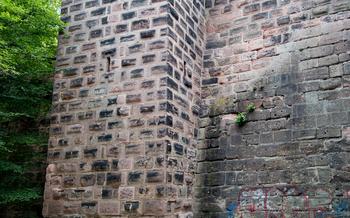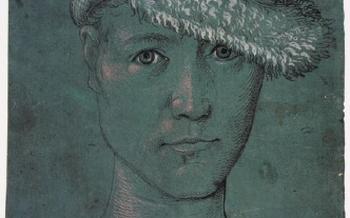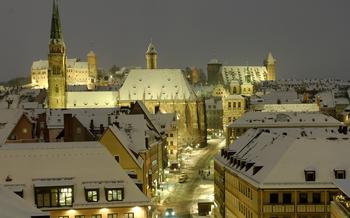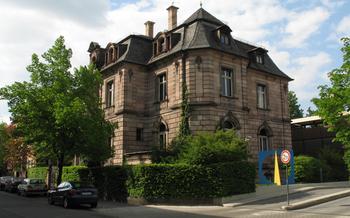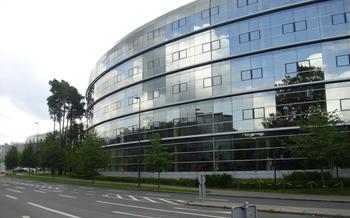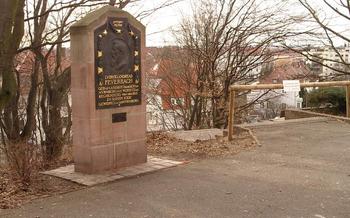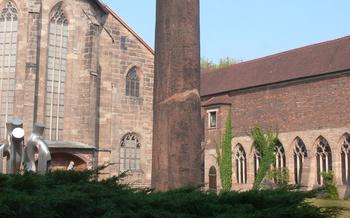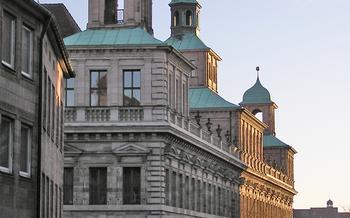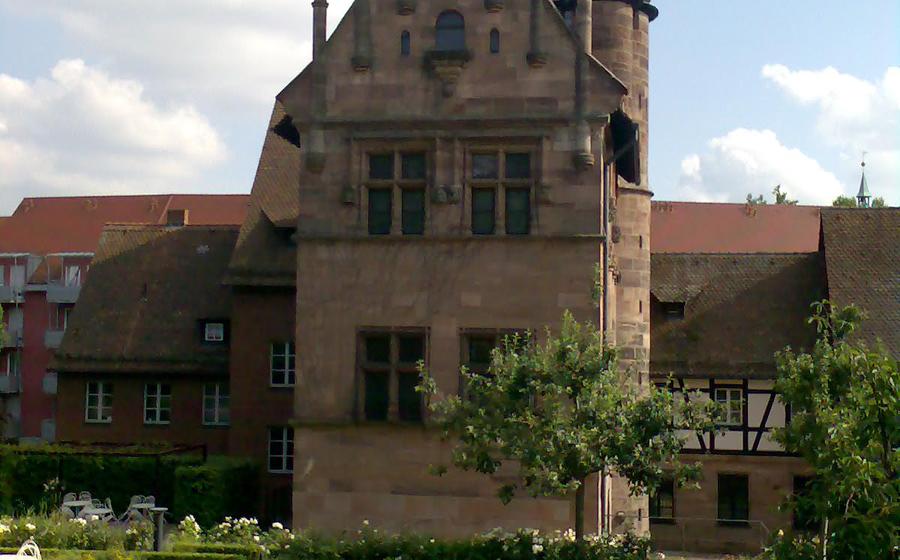
Tucherschloss Museum
- A Trip to Nuremberg
- Tucherschloss Museum: An Overview
- Historical Importance of the Tucherschloss
- Exploring the Museum's Exhibits
- The Knight's Hall: A Majestic Sight
- Tucherschloss Gardens: A Peaceful Retreat
- Events and Workshops at the Museum
- Admission, Hours, and Accessibility
- Location and Transportation
- Nearby Attractions and Landmarks
- Local Cuisine and Restaurants
- Accommodation Options
- Additional Tips for Visitors
- Insider Tip: Hidden Gem
A Trip to Nuremberg
Nuremberg, a captivating city nestled in the heart of Bavaria, Germany, boasts a rich history, vibrant culture, and a plethora of attractions that enchant visitors from around the globe. Embark on a journey through time as you explore this medieval marvel, where history unfolds at every corner. Discover Nuremberg's profound significance as a pivotal imperial city within the Holy Roman Empire, a center for art, trade, and innovation that has shaped the course of European history. Immerse yourself in Nuremberg's vibrant energy and be captivated by its architectural wonders, cultural treasures, and heartfelt hospitality.
Tucherschloss Museum: An Overview
The Tucherschloss Museum is a captivating historical and cultural landmark located in the heart of Nuremberg, Germany. Nestled amidst well-preserved medieval streets, this enchanting edifice boasts a rich history dating back to the 13th century. Initially constructed as a residential palace for the prominent patrician Tucher family, the Tucherschloss served as a symbol of their wealth and influence within the Holy Roman Empire.
Over the centuries, the palace has undergone several renovations and expansions, resulting in a captivating blend of architectural styles. The original Gothic structure, characterized by intricate stone carvings and pointed arches, has been harmoniously integrated with Renaissance and Baroque elements, creating a visually stunning masterpiece.
Today, the Tucherschloss Museum proudly houses an array of captivating exhibitions that narrate the compelling history of the palace and its inhabitants. Visitors can marvel at an impressive collection of artifacts, including furniture, paintings, sculptures, and weaponry, which vividly illustrate the opulent lifestyle of the Tucher family and their significant role in Nuremberg's past.
Historical Importance of the Tucherschloss
The Tucherschloss holds immense historical significance, having played a pivotal role during the Holy Roman Empire. The von Tucher family, a prominent patrician family in Nuremberg, constructed the castle in the 15th century as a symbol of their wealth and power. The von Tuchers were influential figures in the city's political and economic landscape, and their castle served as a meeting ground for important discussions and negotiations.
The Tucherschloss also played a significant role in the city's fortifications. Its strategic location atop the city walls provided a vantage point for monitoring and defending against potential attacks. The castle's sturdy construction and fortified walls made it a formidable defensive structure, contributing to Nuremberg's reputation as a well-protected city.
Moreover, the Tucherschloss bears witness to the rich history of Nuremberg as a center of trade and commerce. The von Tuchers were successful merchants, and their castle served as a hub for their extensive trading activities. The castle's proximity to the city's main trading routes facilitated the exchange of goods and ideas, contributing to Nuremberg's economic prosperity.
Exploring the Museum's Exhibits
The Tucherschloss Museum offers a diverse range of exhibits that bring the history of the building, the Tucher family, and the city of Nuremberg to life. Through interactive displays, multimedia presentations, and historical reenactments, visitors can immerse themselves in the rich past of this iconic landmark.
Interactive displays allow visitors to engage with the museum's collection in a hands-on manner. Touchscreens and interactive panels provide detailed information about the artifacts on display, as well as historical context and insights into the lives of the Tuchers and the people of Nuremberg.
Multimedia presentations transport visitors back in time, recreating significant events and moments from the history of the Tucherschloss and the city. These presentations often incorporate archival footage, animations, and sound effects to create a truly immersive experience.
Historical reenactments add a touch of authenticity to the museum's exhibits. Actors dressed in period costumes bring to life the stories of the Tuchers and other historical figures associated with the castle. These reenactments offer visitors a unique opportunity to witness history firsthand and gain a deeper understanding of the past.
The Knight's Hall: A Majestic Sight
The Knight's Hall, also known as the "Rittersaal," is the heart of the Tucherschloss Museum, captivating visitors with its grand architecture and rich history. This stunning hall, boasting a high vaulted ceiling and adorned with intricate carvings, was once the venue for lavish banquets, celebrations, and official gatherings of the Tucher family and their noble guests.
The hall's impressive architectural features include a series of elegant windows that flood the space with natural light, illuminating the intricate details and vibrant colors of the ceiling frescoes. The walls are adorned with portraits of prominent Tucher family members, each with their own unique story to tell.
Throughout history, the Knight's Hall has witnessed significant historical events and played a crucial role in shaping the destiny of Nuremberg. In 1356, the Golden Bull, a pivotal document that defined the electoral system of the Holy Roman Empire, was signed within these hallowed walls. This momentous act solidified Nuremberg's position as one of the most influential cities in the empire.
Beyond its historical significance, the Knight's Hall holds immense cultural value. It serves as a testament to the artistic prowess and craftsmanship of the Late Middle Ages and Renaissance periods. The hall's intricate carvings, vibrant frescoes, and opulent furnishings offer a glimpse into the lives and tastes of the wealthy and powerful Tuchers.
Tucherschloss Gardens: A Peaceful Retreat
Stroll through the tranquil Tucherschloss Gardens, a haven of serenity in the heart of Nuremberg. Admire the vibrant colors of meticulously maintained flowerbeds, each bloom a testament to the gardeners' artistry. Sculptures and fountains dot the landscape, adding a touch of elegance and whimsy. Take a moment to relax on a bench, surrounded by the gentle rustling of leaves and the sweet fragrance of roses. As you gaze out over the gardens, let your mind wander back to a time when knights and ladies strolled these same paths, enjoying the beauty and tranquility of this special place.
Events and Workshops at the Museum
The Tucherschloss Museum offers a diverse range of events and workshops that delve deeper into the history and culture of Nuremberg. These events provide visitors with an immersive and engaging experience that brings the museum's exhibits to life.
Lectures: Renowned historians, archaeologists, and experts in various fields present informative lectures on topics related to Nuremberg's past, the Tucherschloss, and the Holy Roman Empire. These lectures offer insights into the city's rich history and its significance in shaping German culture and politics.
Concerts: The museum's enchanting ambiance provides a unique setting for classical music concerts, medieval music performances, and traditional Bavarian music events. These concerts transport visitors back in time, allowing them to experience the cultural traditions of Nuremberg's past.
Historical reenactments: The Tucherschloss Museum hosts historical reenactments that bring to life key events and figures from Nuremberg's history. Visitors can witness reenactments of medieval battles, courtly ceremonies, and everyday life in the city during the Middle Ages. These reenactments offer a vivid glimpse into the past and provide a deeper understanding of the city's heritage.
Admission, Hours, and Accessibility
Visiting the Tucherschloss Museum is an enriching experience for history and culture enthusiasts. Admission tickets are reasonably priced, with discounts for students, seniors, and families. Guided tours are available in English and German for a more immersive experience. Visitors can explore the museum during its opening hours, which typically run from 10 am to 5 pm daily. Visitors can also check the museum's official website for any special events or extended hours.
The museum is accessible for visitors with disabilities, featuring ramps, elevators, and accessible restrooms. Additionally, wheelchairs are available for use upon request. With its convenient location and accessibility features, the Tucherschloss Museum welcomes visitors from all backgrounds to delve into the rich history of Nuremberg and the Tucherschloss.
Location and Transportation
The Tucherschloss Museum is situated at Hirschelgasse 9-11 in the heart of Nuremberg's historic city center. Easily accessible by foot or public transportation, the museum is a short walk from the main train station and the central market square, Hauptmarkt.
For those arriving by car, limited street parking is available in the vicinity, but it is advisable to utilize nearby parking garages such as the Parkhaus am Opernhaus or the Parkhaus am Hauptmarkt.
Nearby Attractions and Landmarks
In Nuremberg, there's no shortage of captivating destinations to explore. The magnificent Nuremberg Castle, with its sprawling ramparts and towers, stands testament to the city's imperial history. Within its walls, you'll find the Imperial Castle Museum, showcasing artifacts from the Holy Roman Empire.
The Germanisches Nationalmuseum, one of the largest cultural history museums in Germany, houses an extensive collection spanning from prehistoric times to the present day. Its exhibits on art, archaeology, and ethnography provide a comprehensive insight into German and European history.
For a spiritual experience, visit the awe-inspiring St. Lorenz Church, a masterpiece of Gothic architecture. Admire its soaring spires, intricate stained-glass windows, and the exquisite Tucher Altar, a testament to the city's artistic heritage.
Local Cuisine and Restaurants
Nuremberg, and Franconia as a whole, is renowned for its culinary delights. While visiting the Tucherschloss Museum, make sure to savor the flavors of the region. Bratwurst, a type of grilled sausage, is a must-try. Enjoy it with sauerkraut or potato salad.
For a taste of local history, indulge in Nürnberger Rostbratwürste, small grilled sausages that have been a staple of Nuremberg's cuisine for centuries.
If you prefer vegetarian or vegan options, Nuremberg offers plenty of choices. Schäufele, a roasted pork shoulder, can be substituted with Seitan Braten, a vegan alternative.
Franconian cuisine also offers a variety of dumplings and soups, such as Kartoffelklöße (potato dumplings) or Flädle (pancakes).
After exploring the Tucherschloss Museum, head to one of the many restaurants in the vicinity to enjoy a hearty Franconian meal. Bratwurst-Röslein and Zum Albrecht Dürer are popular choices located close to the museum. Don't miss the chance to experience the culinary traditions of Nuremberg while immersing yourself in its rich history.
Accommodation Options
When planning your stay in Nuremberg, you'll find a wide range of accommodation options to suit every budget and preference.
For a luxurious experience, consider booking a room at one of the city's many upscale hotels, such as the Grand Hotel Nürnberg or the Hotel Nassauer Hof. These hotels offer elegant rooms, top-notch amenities, and convenient locations near the Tucherschloss Museum and other attractions.
If you're looking for a more affordable option, there are several budget hotels and hostels to choose from. These accommodations offer basic but comfortable rooms at a fraction of the cost of higher-end hotels. Some popular options include the City Hotel Nuremberg and the a&o Nürnberg Hauptbahnhof.
For a unique and immersive experience, consider staying in a vacation rental. These rentals, which range from cozy apartments to spacious houses, offer the chance to live like a local and explore Nuremberg at your own pace. Airbnb and Vrbo are popular platforms for finding vacation rentals in the city.
No matter what your budget or preferences, you're sure to find the perfect accommodation in Nuremberg to make your stay comfortable and enjoyable.
Additional Tips for Visitors
-
Souvenirs and Gifts: Before leaving, stop by the museum shop for unique souvenirs and gifts inspired by Nuremberg history and culture. You can find everything from postcards and magnets to replicas of medieval armor and weapons.
-
Photography Guidelines: Photography is allowed inside the museum, but flash photography is prohibited. Please be respectful of other visitors and avoid using tripods or taking photos of people without their permission.
-
Dress Code: There is no specific dress code for visiting the Tucherschloss Museum, but it is recommended to wear comfortable shoes as there is a lot of walking involved.
Insider Tip: Hidden Gem
Beyond the main attractions of the Tucherschloss, there lies a hidden gem that few visitors know about. Tucked away in a secluded corner of the museum, a secret passageway leads to a hidden room, once used as a private chamber by the Tucher family. This hidden room has been preserved in its original state, offering a glimpse into the private lives of the Tuchers. Visitors who stumble upon this hidden gem will feel like they have stepped back in time and are privy to a secret that few others know about.
